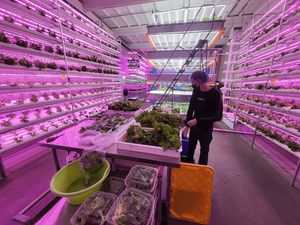
Editor’s Note: This article contains information derived from interviews Agritecture conducted with Fusion Farms and Grupo Vesan, two Puerto Rican indoor farms that have experienced hurricanes.
WRITTEN BY: Sarah Jordan, Isabelle Dom, and Christian Kanlian
Hurricanes can be a leading cause of concern for farmers working in coastal areas where severe weather is common. These storms can interrupt entire seasons of growing, causing significant crop loss and even preventing farmers from planting their next season’s harvest. As storms increase in intensity and cause greater damage and disruption, farmers not only face threats to their livelihoods, but food supply chains risk shortages, which can exacerbate social and health inequities.
As conventional agricultural practices become increasingly untenable for a number of reasons (including its well-established contribution to climate change), controlled environment agriculture is often cited as a reliable solution for extreme weather regions as it offers a level of protection and control that open-air, soil-based farms do not.
Agritecture spoke with Fusion Farms and Grupo Vesan, both located in Puerto Rico, to better understand how this application of CEA can work best and what steps to take to prepare indoor farms for major storms.
Fusion Farms, located in Mayagüez on Puerto Rico’s west coast, is operated by husband and wife team, Kendell Lang and Lisa Jander. After opening in 2016, Fusion Farms faced their first big storm when Hurricane Maria made landfall in 2017. They also made it through Tropical Storm Laura in 2020. Through both of these storms, Fusion Farms experienced little to no interruption to their operation.
Grupo Vesan, founded in 2015 by Francisco Santana, is located in Ponce on the southern side of the island. It endured both Hurricane Maria and Hurricane Fiona in 2022. After Maria, Grupo Vesan resumed operations within 10 days. Having made some adjustments following Maria, Grupo Vesan opened the immediate next day after Hurricane Fiona.
Lessons Learned from Building CEA Farms in Hurricane-Prone Regions
1. Weatherproof Your Building

Lang of Fusion Farms shares that they intentionally selected their farm’s site (a concrete structure constructed in 1961), for its “ great bones”, proven by the fact that it has withstood every hurricane since it was built.
However, for those without access to time-tested buildings or are building a brand new facility, there are various design choices that can help fortify a structure against major storms. Operators planning new farms in hurricane-prone areas should consult local architects and engineers about the best ways to protect their site. Knowing this ahead of time will help with both the design and budget planning process.
2. Consider Alternate Locations for Your HVAC Unit

In commercial applications, HVAC units are commonly installed on rooftops. In line with this practice, Grupo Vesan’s originally had their HVAC units placed on the roof of their building. However, after being damaged during Hurricane Maria, Grupo Vesan relocated their HVAC units to sit against the exterior walls of their buildings and hover closer to the ground but out of reach of potential flood waters. This new location has the added benefit of being out of direct sunlight, which Santana shares has improved their efficiency.
3. Install Backup Generators & Test Capacity Levels

Installing a generator is encouraged for any indoor farm. Interruption to a CEA farm’s power supply can be disastrous and having a generator to supplement that power can ensure that the necessary operations continue.
Both Fusion Farms and Grupo Vesan installed generators during their facility buildout. This foresight allowed the farms to continue operating during both storms and neither one of them suffered any significant crop loss. For Grupo Vesan, after experiencing a 10-day power outage with Hurricane Maria, they added additional capacity to their generator’s fuel storage. The duration of power outages and the inability to access your farm due to road closures, fallen trees, etc. are variable with each storm. Having an independent power supply with enough capacity to withstand extended use can reduce the amount of overall impact.
4. Create an Emergency Storm Preparedness Plan

Creating a standard operating procedure for extreme weather events will look different for each CEA facility. Lang, of Fusion Farms, says their Emergency Storm Preparedness Standard Operating Procedure “is primarily designed to address outdoor impact areas,” and ensures that all equipment is taken indoors or secured properly.
As preparations will vary from farm to farm, it is important that your plan considers all of the unique aspects of your farm and lays out a clear step-by-step process for each part of your operation. Create this plan well in advance of hurricane season to avoid reacting too late. Be sure to review these plans annually to account for any changes made in operations or staffing. Plans need to be as up-to-date as possible; staff needs to be clear on what parts of the plan they are responsible for; and channels of communication should be duly outlined, particularly in instances of lost power and lack of phone service.
5. Be Diligent with (or Even Increase) Your Decontamination Processes

Indoor farms, by their very design, have limited exposure to the amount of pathogens when compared to an open-air, soil-based farm. However, they are not immune, and all farms must be diligent in their processes for preventing contamination.
After hurricanes, the likelihood of people coming into contact with chemical hazards increases, making these decontamination processes that much more important. Fusion Farms operates at a BioSecure level 2, a strict operating procedure that helps mitigate the risk of contamination by persons. Hurricanes may also damage oil refineries, resulting in an increase in air pollutants. To help guard against airborne pathogens, Fusions Farms maintains positive pressure in their airflows to prevent contamination in their grow rooms.
By considering the risks of hurricane damage during the planning stages, vertical farms can protect their crop yields and profits by properly outfitting buildings with hurricane-resistant materials. Assessing these risks and precautionary measures beforehand can help operators avoid future issues and ensure a more resilient food supply for the areas most heavily affected by natural disasters. After Hurricane Fiona, Santana said that Grupo Vesan was “one of the few [farms] that was supplying vegetables” to the local community.
